China’s Hidden Century: 1796–1912
Reviewed by William H. MaWilliam H. Ma
Assistant Professor of Art History
Louisiana State University
Email the author: Williamma1[at]lsu.edu
Citation: William H. Ma, exhibition review of China’s Hidden Century: 1796–1912, Nineteenth-Century Art Worldwide 22, no. 2 (Autumn 2023), https://doi.org/10.29411/ncaw.2023.22.2.19.
This work is licensed under a Creative Commons Attribution-NonCommercial 4.0 International License  unless otherwise noted.
unless otherwise noted.
Your browser will either open the file, download it to a folder, or display a dialog with options.
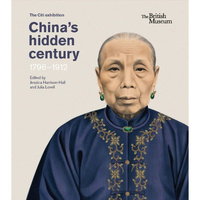
China’s Hidden Century: 1796–1912
British Museum, London
May 18–October 8, 2023
Catalogue:
Jessica Harrison-Hall and Julia Lovell, eds.,
China’s Hidden Century: 1796–1912.
Seattle: University of Washington Press and the British Museum, 2023.
336 pp.; 430 color illus.
$65 (hardcover)
ISBN: 9780295751856
It is not an easy task to put together a major paradigm-shifting exhibition. The task is made doubly difficult when the plan, organization, and execution all take place in the midst of a global pandemic. The curators and organizers of the blockbuster exhibition China’s Hidden Century at the British Museum faced exactly these challenges and rose to overcome them. When I attended the exhibition at the end of May 2023, tickets were sold out for two days.
With the collaboration of over one hundred scholars from fourteen countries, the academic vigor of the exhibition is well-demonstrated. This is evident by the handsomely illustrated catalogue that includes essays from some of the foremost historians of nineteenth-century China. Co-editors historian Julia Lovell and curator Jessica Harrison-Hall played a critical role in shaping both the narratives found in the catalogue and in the exhibition. In her introduction, Lovell plainly states the ultimate goal for both: “This book aspires to convey both the external and internal cataclysms suffered by China, and the diverse, innovative reactions that these crises provoked. For indeed, the experiences of the ‘long 19th century’ form a crucial bridge to Chinese modernity” (10).
Building upon decades of scholarship, it provides a counter-narrative to the so-called “Century of Humiliation,” in which nineteenth-century China was characterized as being in a period of decline, calamities, and defeats. Embraced by both the Nationalist and the Communist governments, this version of history conveniently paved the way for a new government—either the Republic or the People’s Republic. Reading through the articles, the curators and scholars have presented a powerful case in support of this counter-narrative through specific artifacts and newly discovered archival materials. Yet this nuanced approach is difficult to convey persuasively within the space of a museum, as I will discuss later in the review.
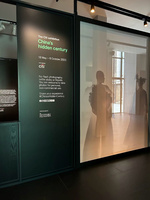
The exhibition toured the “long nineteenth century,” from 1796 (the ascension of the Qing emperor Jiaqing [1760–1820]) to 1912 (the abdication of the last emperor Puyi [1906–67] and the founding of the Chinese republic) and was divided, like the catalogue, into six sections: the Court, the Military, Artists, Urban Life, Global Qing, and Reformers and Revolutionaries. At the beginning of each section, visitors were greeted by a historical figure in silhouette. From the shadows, their voices emerged through the black speakers above (fig. 1). The selection of figures—some famous like the Empress Dowager Cixi (1835–1908), others obscure like Madame Li (ca. 1800–76)—illustrated the commitment of the exhibition to highlight the perspectives of the individual lives of the Chinese people who had lived through the tumultuous period. This is the same strategy used in another recent publication that accompanied the exhibition, Creators of Modern China: 100 Lives from Empire to Republic (1796–1912), published by the British Museum and by the same dual editors as the catalogue.[1] To further chip away at the illusion of a monolithic Chinese voice, the historical figures were also able to tell their own stories in their own native tongues of Manchu, Cantonese, Shanghainese, or Mandarin, followed by an English translation through a voice actor.
The use of these speaking historical figures raised several issues. The words of the female revolutionary martyr Qiu Jin (1875–1907) in the final section gave rise to a heated controversy that I will address later in this review. Here I note that, in order to capture the diversity of voices and to repackage them as a part of an immersive gallery experience, selections and edits had to be made, generating effects and perspectives that were perhaps unintended by the curators. Take, for example, Madame Li (wife of Mr. Lu Xifu [ca. 1800–76]), whose likeness graced the cover of the catalogue and so many of the publicity images for the exhibition. An ordinary middle-class woman from the southern Chinese town of Foshan, her “voice” was resurrected by a woman speaking in Cantonese. But the narrative was in fact based on the eulogy written by her nephew attached to the portrait, and it predictably emphasizes her roles as a mother and a moral compass in the typical Confucian mode:
I serve my parents-in-law with filial respect and get along well with my sisters-in-law. I keep wines for every elegant excursion. The sound of the loom is constant under my hands. I watch over my sons as they study late into the night. I live in harmony with my husband’s concubines. I pity the poor and less fortunate. I am charitable and enjoy doing good deeds. I am a Buddhist and always keep a vegetarian diet. I have many children and grandchildren. As the parents are kind, so the children are filial.[2]
The effort to recover female and other minority voices in historical records is notoriously difficult in China, but in this case the attempt to “return” a voice to the voiceless only reinforces tired stereotypes historically associated with Chinese women. Furthermore, as one of a pair of ancestral portraits, Madame Li’s portrait was originally intended to be used in private rituals within the clan; they were never meant to be seen by people outside of the family. To splash a cropped, close-up image of her likeness across so many public platforms was inappropriate, if not an outright violation of Madame Li. In another section of the exhibition, Empress Dowager Cixi’s voice could be heard expressing her thoughts on her contemporary Queen Victoria (1819–1901). In a recording, the empress, an often-vilified figure in Chinese history, endlessly repeated the pronouncement, “I have often thought that I am the cleverest woman that ever lived.” One walks away from this encounter with no more fondness for her than before.
Given the enormous scope and task of the exhibition, the curators, scholars, and organizers should be applauded for this monumental achievement in light of the many obstacles in the past few years. Despite the effort of China’s Hidden Century to rebrand nineteenth-century China as a period of change, resilience, and adaptation, it is difficult to exorcise the specter of the “Century of Humiliation.” Ingrained by their grade-school history lessons and reinforced by social media, many visitors, especially those from mainland China, remained unmoved and unconvinced by the new perspective.[3]
In many ways, their perspective was confirmed by selected historical artifacts from the exhibition that highlighted the major defeats that Qing China suffered, many at the hands of Western foreigners like Great Britain: the two Opium Wars, the Taiping Rebellion, the Boxer Rebellion, etc. These crucial historical events were well-represented in China’s Hidden Century through a careful selection of historical documents such as the 1842 Treaty of Nanjing that ceded Hong Kong to Great Britain (fig. 2) and the handwritten response of the leader of the Taiping Rebellion, Hong Xiuquan (1814–64), to a British missionary expressing his own heterodox interpretation of the Christian God. Unfortunately, the placement of these important documents next to or near other visually arresting artifacts greatly diminished their recognition and significance for visitors unfamiliar with nineteenth-century Chinese history. For example, the Treaty of Nanjing was relegated to a corner in between an unusual Chinese portrait of Queen Victoria (fig. 3) and an endearing oil portrait of her pet Pekinese dog (fig. 4), the latter being a gift from the ruins of the Summer Palace outside of Beijing after the end of the Second Opium War in 1860 and distastefully named Looty.
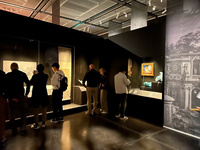
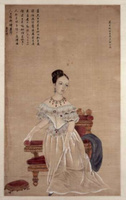
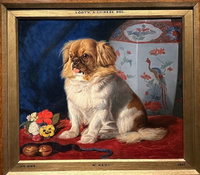
Some works that the catalogue asserted were in the exhibition were in fact not, or they were present only in reproductions. In the same display cabinet as the Treaty of Nanjing and the Queen Victoria portrait was a handscroll portrait of the opium-burning official Lin Zexu (1785–1850), another critical historical figure in the First Opium War. The lack of any seals or colophons on the painting is befuddling, until one realizes that it is a reproduction. While the practice of inserting reproductions alongside original artworks is common in Chinese museums, it is unusual in British art museums. In the section highlighting prints and paintings, visitors could only see and hear the Shanghai School artist Ren Xiong (1823–57) through his voice and silhouette, but not the famous self-portrait on which both were based. As a pictorial emblem of the beginning of individualism in modern China, the painting’s absence is palpable. It seems like the organizers had intended to include many works from Chinese and overseas collections, but none of them were in the exhibition; I suspect they were casualties of the long lockdown when the borders were closed. Instead, the gaps were filled by works from private collections; most of the Shanghai School paintings came from the collection of Michael Yun-Wen Shih, or from collections in Great Britain. In my view, these limitations created excellent opportunities for the British Museum curators to explore in greater depth works not often seen by the public from their own collection. Indeed, the exhibition’s own blog speaks on these opportunities to conserve rarely seen works from the straw rain cape (fig. 5) to dried shark’s fin.[4] Intentional or not, these rarely seen or regarded objects allow visitors to experience a more comprehensive and concrete sense of the place, time, and people in nineteenth-century China.
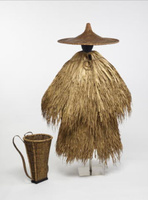
Some objects in the exhibition raise interesting questions of provenance. Why, one might ask, would a straw rain cape, a shark’s fin, and ancestral portraits be in the collection of the British Museum? In fact, this raises further questions about the role of the British Museum as a repository and guardian of knowledge and objects from the British colonial past.
A fellow academic pointed out that the title China’s Hidden Century is a misnomer. What the exhibition has demonstrated is that China was anything but “hidden” in the nineteenth century. Thanks to the advent of modern transportation and communication networks, people around the world were able to read, hear, and watch events that took place in China within days. For example, within less than a year of the Summer Palace’s destruction at the hands of the Franco-British army in 1860, the French novelist Victor Hugo (1802–85) was able to lament the loss of “a wonder of the world.”[5] In the effort to modernize, citizens of the Qing Empire traveled to Japan, Europe, and the United States, but the world also came to China. Armed with a sense of civilizational superiority and protected under treaties imposed on Qing China by Western imperialism, foreigners penetrated ever deeper into the heart of the empire with the latest technological wonders such as the camera, recording and collecting everything they saw along the way; the large number of ethnographic materials in the section Urban Life in the exhibition was a direct result of this practice.
The uncomfortable role of the British Museum in the continual preservation of the British Empire’s colonial past has been long and frequently pointed out by academics and more recently on social media and popular media outlets, and the call for the repatriation of looted objects has been steadily increasing in volume, yet the British Museum has remained steadfast in its refusal to offer any forms of concession.[6] While China’s Hidden Century acknowledged the role of the British colonial legacy in shaping the history of nineteenth-century China, its specific historical role was buried in scholarly essays and explanatory labels. As many of the catalogue essay writers’ own works have demonstrated, the role of Great Britain in the shaping of nineteenth-century China was enormous, from its starring role in the Opium Wars and the subsequent treaties, to its persistent control of colonial spaces like Hong Kong, to the introduction of industrial technologies. The exhibition design and the objects on display obscured that colonial perspective.
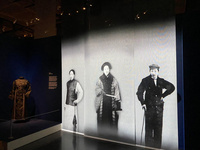
Deliberate or not, this oversight was amplified to a major issue when it was revealed on social media in June that at least one of the translations used in the exhibition was uncredited and uncompensated. The issue originated with the final silhouette and text, which featured the female revolutionary Qiu Jin, who was executed in 1907 after her failed attempt in a revolt against the Qing dynasty. A few lines from a poem by Qiu appeared in the exhibition, and it was recited over the speakers in Mandarin and in English at the end of the exhibition as the final encounter with a nineteenth-century historical figure. The English version was translated by the Vancouver-based Yilin Wang. Through social media, Wang discovered her translation was used without her knowledge or compensation, and she protested vigorously online. The British Museum responded by taking away both her translation and the Chinese original. Since the text is no longer recited, both Qiu and her translator’s voices are silenced, literally and metaphorically, prompting the accusation of erasure of two women of color by the museum (fig. 6).[7] In August, Wang was finally compensated and received an apology.[8] Given the difficulties in the last few years and the number of people involved in the exhibition, I believe the British Museum was sincere when they called the incident an “unintentional human error.”[9] But as a premier institution on the global stage and an inheritor of its colonial legacy, it is beholden to a higher standard. It has a responsibility to the past and the present, and the construction of a just future. Ghosts of the museum’s colonial past will not be going away any time soon.
Notes
[1] Jessica Harrison-Hall and Julia Lovell, eds., Creators of Modern China: 100 Lives from Empire to Republic (1796-1912) (Thames & Hudson, 2023).
[2] See “Madam Li (Mrs. Lu),” China resources, The British Museum, accessed September 3, 2023, https://www.britishmuseum.org/.
[3] For one example of the persistence of the “Century of Humiliation” narrative being circulated in mainland Chinese social media, see this popular post on Douyin, the Chinese version of Tik Tok, July 16, 2023, @董太太(自己姓董), 没有一个中国人可以笑着从大英博物馆走出来#女性 #大英博物馆 #英国 #历史#教育, https://www.douyin.com/.
[4] “Fabulous fibres for China’s hidden century,” The British Museum blog, April 17, 2023, https://www.britishmuseum.org/.
[5] Victor Hugo, “On the Sacking of the Summer Palace,” Napoleon.org, https://www.napoleon.org/.
[6] See for example, Max Colchester, Elissa Miolene, and Kelly Crow, “The British Museum Holds the Line on Its Imperial Loot,” Wall Street Journal, March 24, 2023, https://www.wsj.com/ [login required].
[7] Elaine Velie, “Translator Calls Out British Museum’s ‘Erasure’ of Her Work,” Hyperallergic, June 27, 2023, https://hyperallergic.com/.
[8] Jessie Yeung, “British Museum agrees to pay translator whose work it used without permission,” CNN, August 9, 2023, https://www.cnn.com/.
[9] “Public statement on copyright issue linked to the exhibition China’s hidden century,” Public statement, The British Museum, June 22, 2023, https://www.britishmuseum.org/.